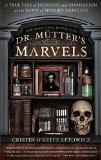Summary | Excerpt | Reviews | Beyond the Book | Readalikes | Genres & Themes | Author Bio
A True Tale of Intrigue and Innovation at the Dawn of Modern Medicine

Critics' Opinion:
Readers' Opinion:
First Published:
Sep 2014, 384 pages
Paperback:
Sep 2015, 384 pages
 Book Reviewed by:
Book Reviewed by:
Poornima Apte
Buy This Book
Le tour d'abandon ("the desertion tower") was merely a box attached to the hospital, constructed with two sliding doors and a small, loud bell. An infant was unceremoniously placed in the box, the door firmly closed behind it, and the bell was rung. Upon hearing the bell, the nurses on duty would go to le tour to remove the infant, replace the box to its original position, and wait. Every night, a dozen or so infants were received in precisely this way.
For a while, it had been in vogue for wealthy, childless individuals to adopt children from the Hôpital des Enfants-Trouvés to bring up as their own, but the practice had long since fallen out of fashion. At the time of Mutter's visit, more than sixteen thousand children were considered wards of the Hôpital des Enfants-Trouvés, and of those, only twelve thousand would live to adulthood.
There were hospitals for lunatic women and for idiot men, hospitals for the incurable, for the blind, for the deaf and dumb, and even for ailing elderly married couples who wished to die together—they could stay in the same large room provided that the furniture they used to furnish their room became the property of the hospice upon their deaths.
And perhaps most astonishing to the visiting American doctors, Paris had the École Pratique d'Anatomie, which provided any doctor, for six dollars, access to his own cadaver for dissection. In America, cadaver dissection was largely illegal. Many doctors resorted to grave robbing to have the opportunity to examine the human body fully. In Paris, twenty doctors at a time would whittle a human body down to its bones—provided they could stand the smell and the ultimate method of disposal of the dissected corpses: At day's end, the decimated remains were fed to a pack of snarling dogs kept tied up in the back.
However, more than any single hospital, what most attracted Mutter to Paris were the surgeons: brilliant and daring men who were to him living gods, redefining medicine and at the zenith of their renown.
Mutter had always loved surgical lectures and made sure he secured seats as close to the front as possible. In Philadelphia, there were two great medical colleges—the University of Pennsylvania and Jefferson Medical College—and it was customary for the rival schools to hold surgical demonstrations so that prospective students could choose between them, a glorified public relations exercise. Mutter loved the daringness of the surgeries attempted during this time. The lectures were often packed, as eager established and prospective doctors thrilled at the city's best surgeons attempting to outdo one another with their skill and showmanship. However, the combination of ambitious surgeries and unprepared young men sometimes proved disastrous. On one occasion, a Jefferson Medical College professor attempted a daring removal of a patient's upper jaw, using marvelous speed to incise the face and rip out the bones with a huge forceps. But the surgery was perhaps too much for a public display. Doctors who were present would later recall the spectacle of it, how the partially conscious patient spat out blood, bones, and teeth, while unnerved students in the audience vomited and fainted in their seats.
But regardless of how brutal or simple the case, all surgical lectures were a challenge to watch. The anxious patient would be publicly examined and forced to listen to his surgery loudly outlined to an audience of strangers. Next, the patient would nervously drink some wine with the hope that it would dull the nerves and lessen the pain. (In Paris, the need for medicinal wine was so great, the hospital system maintained its very own wine vaults, spending more than 600,000 francs a year on an extensive collection of red and white wine housed exclusively for its patients.)
The patient was then instructed to lie on the surgical table, where he would be held down by the surgeon's assistants and told to stay as still as possible. Everyone—the patient, the doctor, even the students in their seats—knew how impossible this command would be to follow.
Excerpted from Dr. Mütter's Marvels by Cristin O'Keefe Aptowicz. Copyright © 2014 by Cristin O'Keefe Aptowicz. Excerpted by permission of Gotham Books. All rights reserved. No part of this excerpt may be reproduced or reprinted without permission in writing from the publisher.





The Flower Sisters
by Michelle Collins Anderson
From the new Fannie Flagg of the Ozarks, a richly-woven story of family, forgiveness, and reinvention.

The House on Biscayne Bay
by Chanel Cleeton
As death stalks a gothic mansion in Miami, the lives of two women intertwine as the past and present collide.

The Funeral Cryer by Wenyan Lu
Debut novelist Wenyan Lu brings us this witty yet profound story about one woman's midlife reawakening in contemporary rural China.
Your guide toexceptional books
BookBrowse seeks out and recommends the best in contemporary fiction and nonfiction—books that not only engage and entertain but also deepen our understanding of ourselves and the world around us.